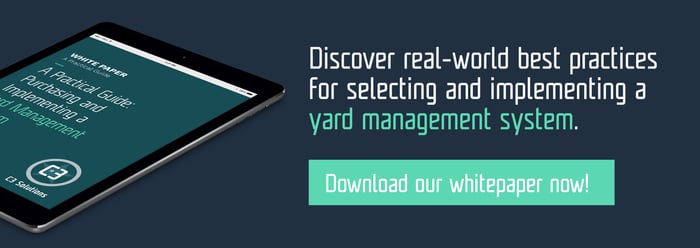5 Key Factors to Consider when Purchasing a Yard Management System

Selecting and implementing a new information system can be a challenge. Entire industries exist to assist companies in purchasing and implementing mainstream systems such as warehouse management (WMS), transportation management (TMS) and enterprise resource planning systems (ERP). The criteria for selecting a strategic enterprise system are not the same for smaller point solutions. Often times, when purchasing a point solution, companies either apply an approach that is not relevant or they simply do not apply adequate resources to these types of projects. In this blog, we will provide some simple advice on what to consider when purchasing a yard management system (YMS). In fact, we believe there are five key points that need to be answered when selecting and implementing a YMS.
Establish the key business issues a YMS needs to resolve.
While this point seems obvious, as a solution provider, we often find that operators have a difficult time quantifying the real impact of a poorly managed yard. For example, a retailer might have issues locating trailers within their yard. This is an operational problem that is typically measured in minutes wasted looking for the trailer. However, the key business issue is that these delays impact the punctuality of the unloading of the products which, in turn, means that retail outlets are not getting the product in time and therefore are missing sales opportunities. Too often we see companies focusing on the low-level operational issues and lose sight of the bigger picture to the detriment of the overall project return on investment.
Determine the extent your YMS will be integrated into the rest of your supply chain systems.
This is often regarded as “Will the system be a stand-alone system or not?”. This question is often best answered once we have identified the key business processes that we need to improve. If, for example, we have determined that the real issue is to improve our on-time delivery to stores, it will be essential that the yard system receives a data feed from the TMS. There may also be other existing systems that need to receive information from the YMS. Either of these scenarios will dictate that the YMS needs to be integrated into the existing supply chain systems and this will necessitate internal IT resources.
Do you have the commitment from the rest of the organization?
Upper management commitment to a project is essential to the success of any operational initiative. Often times we will see that a YMS project is initiated from a particular department (e.g.,transportation). This initially may make sense since most of the costs and benefits come from the transportation department. However a yard management project will necessarily require cooperation from several departments within the organization. Business processes will need to change and this will affect areas of the business that may not receive as much benefit from the project. An executive sponsor needs to be able to convey the corporate goals to all of the affected departments and ensure that there is buy-in and commitment at all levels.
Decide if the solution will be SaaS or on-premise.
In today’s environment this is getting to be more and more of a non-issue, however, it is still very important to resolve this question before beginning your search for a solution. Some of the factors to consider are:
- What is the current workload of my IT department - will they be able to support the system?
- Given the scarcity of my IT resources is this project strategic enough that I allocate internal resources towards it?
- What are the short and long-term cost consequences of hosting internally versus external?
- Will this decision limit my choice of possible solutions (i.e., do vendors offer both on-premise or SaaS)?
For more information on the pros and cons of SaaS supply chain systems, we invite you to read our Top Must-Reads on Cloud Supply Chain Systems.
Determine the type of system - best of breed or existing system offering.
Your existing WMS or TMS solution probably already provides a YMS solution as a module - you might already own this solution. If that is the case, the 2nd point we mentioned might be a non-issue. However, the essential objective is will the YMS module allow you to achieve your desired benefits? Regardless of which approach you choose there are several solution elements that you should consider:
- What is the experience level of the vendor in regards to yard management?
- What is the technology foundation of the solution? Is this recent technology (i.e., web based), and how committed is the vendor to supporting it?
- What type of mobile technology is being used? Does the solution use proprietary devices or are common devices built on operating systems such as Android supported?
- How flexible is the solution? Can the solution be configured to fit your business processes or will you need to change your way of operating to fit the solution?
A major change at any level is always challenging; selecting and implementing a software solution is no exception. As a provider of a yard management solution, we often find that companies begin their search with incomplete information in terms of the potential benefits and impact to the operation that a YMS will provide. We hope these 5 factors will be beneficial in your preparation of selecting a system and the ultimate success of implementing one.

